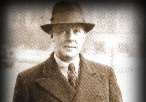|
Sara de Mestre (1877-1961) was the fifth child and elder daughter of
André, and distinguished herself as a nurse in World War I. She commenced her war service at Rabaul, then went on to
Lemnos, Greece, in 1915 to nurse sick and wounded Australian soldiers. She continued her self-sacrificing work in Egypt
and was then transferred to France where she was second-in-charge of the No. 3 Australian General Hospital. Decorations
gained by her were the 1914 -15 ribbon, the Allies ribbon and the Royal Red Cross which was presented at Buckingham Palace
by King George V.
Margaret de Mestre (1915-1942) was a nurse who was trained at Prince
Alfred Hospital in Sydney and was killed in Darwin during World War II when the hospital ship, Manunda, was bombed.
Her father James lived at Bellingen, NSW, and Margaret's name is listed on the War Memorial in Bellingen's main street.
|
 |
|
| Roy de Maistre |

|
| My great-uncle Roy who I met at his studio in Eccleston Street, London. |
Leroy Leveson Laurent Joseph de Maistre was the ninth child of Etienne and
Clara. He was born 27th March, 1894 and was successful as an artist. He was brought up near Sutton Forest at a
house which is reputed to have been a former country residence of the Governors of NSW. (Sydney Morning Herald, 28 May
1960). He was educated at home with his brothers and sister by tutors and governesses, and studied music as well as
painting. In 1916 he joined the Australian Army but was discharged after nine months with tuberculosis.
In 1919, one of Australia's most controversial art exhibitions was held in Sydney. Called "Colour in Art", it attracted
a crowd of 700 to the opening, an occasion of fervent debates by all accounts. The cause of the furore was the artists'
use of colour. One of the artists was Roy de Maistre, a young musician-turned-painter, whose musical training was evident
in the titles of many paintings on display. "Still-Life Study in Blue-Violet Minor" was typical: while the
subject was realistic the colours were chosen to harmonise like the notes in music. Blue-violet was supposed to
be F sharp, so this painting was designed in colours aligned to the key of F sharp minor. Hung at the back of
the exhibition were de Maistre's colour charts, showing how specific musical notes corresponded to different hues to form
a colour-music code.
After de Maistre's death in 1968, the charts found their way to the Art Gallery of NSW, and so colour music gained a
permanent place in Australian art history. Their importance had been guaranteed when, in 1959, the large painting
"Rhythmic Composition in Yellow-Green Minor" surfaced at auction. Dated 1919, it was hailed as the first example
of Australian abstraction, composed by de Maistre on colour-music principles. Heather Johnson's book "Roy de Maistre:
The English Years, 1930 to 1968" throws fresh light on later work. Like the first volume of his biography, "Roy
de Maistre: The Australian Years, 1894 to 1930", it emphasises the continuing importance of colour music to this artist.
In 1923 he went to Europe on an Art Scholarship, but returned to Australia a few years later. In 1929 he went to France
where he lived at St. Jean de Luz for the remaining years preceding World War II. He moved to London in 1938 and lived
there until his death in 1968. His 'Stations of the Cross' series hangs in Westminster Cathedral and works of his are
hung in the Tate Gallery, London and in the Art Gallery of New South Wales. He adopted a different form for the spelling
of his surname in the middle 1920's.
|
 |
|